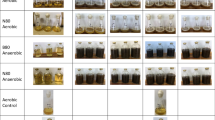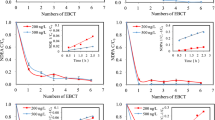Abstract
The feasibility of employing sequential treatment method for detoxification of endosulfan using metal-mediated reductive reactions followed by bacterial oxidation was demonstrated. Gas chromatography revealed that zero-valent magnesium (Mg0) was able to remove 70% of 10 mg L−1 of endosulfan, while the bimetallic system, Mg0/Pd0–carbon, was able to remove 92% of 10 mg L−1 of endosulfan after 30 min of reaction. Monometallic and bimetallic systems resulted in the accumulation of lower chlorinated compounds and hydrocarbon end product(s) in the reaction medium. Lower chlorinated and dechlorinated products were subjected to aerobic biodegradation using the bacterial isolate, Agrobacterium strain PT-3. Residual concentrations of endosulfan isomers and products were reduced to below-detectable levels following 3.5 to 4 h of biological treatment. Recycling of immobilized Pd0 (Pd0–carbon) is required to reduce the expense of treatment process. Results obtained in this study indicated that a sequential Mg0 or Mg0/immobilized palladium-biological treatment approach may be useful for the disposal of post-expiry-dated endosulfan or remediation of pesticide contaminated sites. The integrated technology would be beneficial in terms of reducing the time as well as overall cost for the treatment endosulfan in comparison with individual chemical or biological treatment methods. In addition, this approach will eliminate the risk of accumulation of metabolites that may pose toxicity.







Similar content being viewed by others
References
Agnihotri P, Mahindrakar AB, Gautam SK (2011) Dechlorination of endosulfan and lindane using Mg0/Pd+4 bimetallic system. Water Environ Res 83(9):865–873
ATSDR (Agency for Toxic Substances and Disease Registry) (2015) U.S. Department of Health and Human Services, Toxicological Profile for Endosulfan, Atlanta, Georgia, USA
Bajaj A, Pathak A, Mudiam MR (2010) Isolation and characterization of a Pseudomonas sp. strain IITR01 capable of degrading α-endosulfan and endosulfan sulfate. J Appl Microbiol 109(6):2135–2143
Barry MJ, Davies W (2004) Effects of invertebrate predators and a pesticide on temporary pond microcosms used for aquatic toxicity testing. Environ Pollut 131(1):25–34
Begum A, Gautam SK (2012) Endosulfan and lindane degradation using ozonation. Environ Technol 33(8):943–949
Begum A, Agnihotri P, Mahindrakar AB, Gautam SK (2017) Degradation of endosulfan and lindane using Fenton’s reagent. Appl Water Sci 7:207–215
Bratsch SG (1989) Standard electrode potentials and temperature coefficients in water at 298.15 K. J Phys Chem Ref Data 18(1):1–21
Calvin NN, Onyedika NC, Emmanuel GC, Nkiruka IB (2017) Biodegradation of endosulfan by mixed bacteria culture strains of Pseudomonas aeruginosa and Staphylococcus aureus. Sci World J 12(1):9–12
Chang C, Lian F, Zhu L (2011) Simultaneous adsorption and degradation of γ-HCH by nZVI/Cu bimetallic nanoparticles with activated carbon support. Environ Pollut 159(10):2507–2514
Chaplin BP, Shapley JR, Werth CJ (2007) Regeneration of sulfur-fouled bimetallic Pd-based catalysts. Environ Sci Technol 41(15):5491–5497
Chaplin BP, Reinhard M, Schneider WF, Schuth C, Shapley JR, Strathmann TJ, Werth CJ (2012) Critical review of Pd-based catalytic treatment of priority contaminants in water. Environ Sci Technol 46(7):3655–3670
Dsikowitzky L, Nordhaus I, Sujatha CH, Akhil PS, Soman K, Schwarzbauer J (2014) A combined chemical and biological assessment of industrial contamination in an estuarine system in Kerala, India. Sci Total Environ 485–486:348–362
Engelmann MD, Doyle JG, Cheng IF (2001) The complete dechlorination of DDT by magnesium/palladium bimetallic particles. Chemosphere 43(2):195–198
Harikumar PS, Jesitha K, Megha T, Kokkal K (2014) Persistence of endosulfan in selected areas of Kasaragod District, Kerala. Curr Sci 106(10):1421–1429
He N, Li P, Zhou Y, Fan S, Ren W (2009) Degradation of pentachlorobiphenyl by a sequential treatment using Pd coated iron and an aerobic bacterium (H1). Chemosphere 76(11):1491–1497
Jesitha K, Nimisha KM, Manjusha CM, Harikumar PS (2015) Biodegradation of endosulfan by Pseudomonas fluorescens. Environ Process 2(1):225–240
Jin Z, Nackashi D, Lu W, Kittrell C, Tour JM (2010) Decoration, migration, and aggregation of palladium nanoparticles on graphene sheets. Chem Mater 22(20):5695–5699
Keane MA (2011) Supported transition metal catalysts for hydrodechlorination reactions. ChemCatChem 3(5):800–821
Kim YM, Murugesan K, Chang YY, Kim EJ, Chang YS (2012) Degradation of polybrominated diphenyl ethers by a sequential treatment with nanoscale zero valent iron and aerobic biodegradation. J Chem Technol Biotechnol 87(2):216–224
Lu Y, Morimoto K, Takeshita T, Takeuchi T, Saito T (2000) Genotoxic effects of alpha-endosulfan and beta-endosulfan on human HepG2 cells. Environ Health Perspect 108(6):559–561
Misra SS, Joshi S (2017). Tracking decades-long endosulfan tragedy in Kerala. Down to Earth. http://www.downtoearth.org.in/coverage/tracking-decades-long-endosulfan-tragedy-in-kerala-56788. Accessed 30 Jan 2018
Munoz M, de Pedro ZM, Casas JA, Rodriguez JJ (2013) Chlorophenols breakdown by a sequential hydrodechlorination-oxidation treatment with a magnetic Pd-Fe/γ-Al2O3 catalyst. Water Res 47(9):3070–3080
Murugesan K, Bokare V, Jeon JR, Kim EJ, Kim JH, Chang YS (2011) Effect of Fe–Pd bimetallic nanoparticles on Sphingomonas sp. PH-07 and a nano-bio hybrid process for triclosan degradation. Biores Technol 102(10):6019–6025
Ordonez S, Vivas BP, Diez FV (2010) Minimization of the deactivation of palladium catalysts in the hydrodechlorination of trichloroethylene in wastewaters. Appl Catal B 95(3–4):288–296
Park Y, Ayoko GA, Kurdi R, Horvath E, Kristof J, Frost RL (2013) Adsorption of phenolic compounds by organoclays: implications for the removal of organic pollutants from aqueous media. J Colloid Interface Sci 406:196–208
Patocka J, Wu Q, Franca TCC, Ramalho TC, Pita R, Kuca K (2016) Clinical aspects of the poisoning by the pesticide endosulfan. Quim Nova 39(8):987–994
Paul V, Balasubramaniam E (1997) Effect of single and repeated administration of endosulfan on behavior and its interaction with centrally acting drugs in experimental animals: a mini review. Environ Toxicol Pharmacol 3(2):151–157
Pereira VM, Bortolotto JW, Kist LW, Azevedo MB, Fritsch RS, Oliveira Rda L, Pereira TC, Bonan CD, Vianna MR, Bogo MR (2012) Endosulfan exposure inhibits brain AChE activity and impairs swimming performance in adult zebrafish (Danio rerio). Neurotoxicology 33(3):469–475
Peterson SM, Batley GE (1993) The fate of endosulfan in aquatic ecosystems. Environ Pollut 82(2):143–152
Pillai HPS, Kottekottil J (2016) Nano-phytotechnological remediation of endosulfan using zero valent iron nanoparticles. J Environ Prot 7(5):734–744
Pradeep V, Subbaiah UM (2016) Use of Ca-alginate immobilized Pseudomonas aeruginosa for repeated batch and continuous degradation of Endosulfan. 3 Biotech 6(2):124
Santhanalakshmi J, Komalavalli R, Venkatesan P (2012) Photo catalytic degradation of chloropyrifos, endosulphon, iimidocloprid and quinolphos by nano crystalline TiO2—a kinetic study with pH and mass effects. Nanosci Nanotechnol 2(1):8–12
Saxe JP, Lubenow BL, Chiu PC, Huang CP, Cha DK (2006) Enhanced biodegradation of azo dyes using an integrated elemental iron-activated sludge system: II. Effects of physical-chemical parameters. Water Environ Res 78(1):26–30
Schuth C, Kummer NA, Weidenthaler C, Schad H (2004) Field application of a tailored catalyst for hydrodechlorinating chlorinated hydrocarbon contaminants in groundwater. Appl Catal B 52(3):197–203
Singh SP, Bose P (2017) Reductive dechlorination of endosulfan isomers and its metabolites by zero-valent metals: reaction mechanism and degradation products. RSC Adv 7(44):27668–27677
Sivagami K, Vikraman B, Krishna RR, Swaminathan T (2016) Chlorpyrifos and endosulfan degradation studies in an annular slurry photo reactor. Ecotoxicol Environ Saf 134(Part 2):327–331
Stylianou SK, Szymanska K, Katsoyiannis IA, Zouboulis AI (2015) Novel water treatment processes based on hybrid membrane-ozonation systems: a novel ceramic membrane contactor for bubbleless ozonation of emerging micropollutants. J Chem. https://doi.org/10.1155/2015/214927
Sunderam RIM, Thompson GB, Cheng DMH (1992) Toxicity of endosulfan to native and introduced fish in Australia. Environ Toxicol Chem 11(10):1469–1476
Tang S, Wang XM, Yang HW, Xie XF (2013) Haloacetic acid removal by sequential zero-valent iron reduction and biologically active carbon degradation. Chemosphere 90(4):1563–1567
Tejamaya M, Römer I, Merrifield RC, Lead JR (2012) Stability of citrate, PVP, and PEG coated silver nanoparticles in ecotoxicology media. Environ Sci Technol 46(13):7011–7017
Thangadurai P, Suresh S (2011) Dechlorination of endosulfan using metal mediated systems. In: Proceedings of the 12th international conference on environmental science and technology, Rhodes, Greece, pp B1034–B1041
Thangadurai P, Suresh S (2013) Reductive transformation of endosulfan in aqueous phase using magnesium–palladium bimetallic systems: a comparative study. J Hazard Mater 246–247:245–256
Thangadurai P, Suresh S (2014) Biodegradation of endosulfan by soil bacterial cultures. Int Biodeterior Biodegradation 94:38–47
The Hindu (2011) Supreme Court bans endosulfan across the country for 8 weeks. http://www.thehindu.com/news/national/supreme-court-bans-endosulfan-across-the-country-for-8-weeks/article2015706.ece. Accessed 30 Jan 2018
Vijaiyan SG, Rajam A (2013) Degradation of endosulfan using Pseudomonas sp. ED1 isolated from pesticide contaminated soil. J Acad Ind Res 2(3):170–175
Wang JL, Xu LJ (2012) Advanced oxidation processes for wastewater treatment: formation of hydroxyl radical and application. Crit Rev Environ Sci Technol 42(3):251–325
Wang ZL, Yan JM, Wang HL, Ping Y, Jiang Q (2012) Pd/C synthesized with citric acid: an efficient catalyst for hydrogen generation from formic acid/sodium formate. Sci Rep 2: https://doi.org/10.1038/srep00598
Yedla S, Dikshit AK (2008) Removal of endosulfan from water using wood—adsorption and desorption. J Environ Eng ASCE 134(2):102–110
Acknowledgements
The authors acknowledge IIT Bombay for providing infrastructure and financial support to execute this project. The authors also thank Mr. Sengottaiyan Murugan for his assistance with GC–MS facility at the Department of Chemistry, IIT Bombay, Mumbai, India.
Author information
Authors and Affiliations
Corresponding author
Additional information
Editorial responsibiility: Binbin Huang.
Electronic supplementary material
Below is the link to the electronic supplementary material.
Rights and permissions
About this article
Cite this article
Suresh, S., Thangadurai, P. Coupling of zero-valent magnesium or magnesium–palladium-mediated reductive transformation to bacterial oxidation for elimination of endosulfan. Int. J. Environ. Sci. Technol. 16, 1421–1432 (2019). https://doi.org/10.1007/s13762-018-1748-1
Received:
Revised:
Accepted:
Published:
Issue Date:
DOI: https://doi.org/10.1007/s13762-018-1748-1




